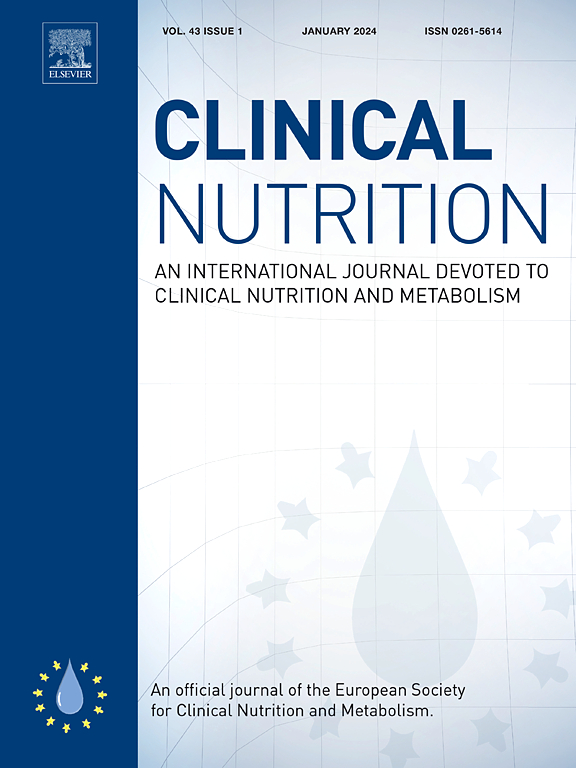循环中 3- 羟丁酸水平与恶性肿瘤之间的遗传预测因果关系:一项泛癌症孟德尔随机化研究。
IF 6.6
2区 医学
Q1 NUTRITION & DIETETICS
引用次数: 0
摘要
目的:生酮饮食或外源性补充 3-hydroxybutyrate (3HB) 逐渐被认为是一种有价值的治疗或健康干预策略。然而,在以往的研究中,3HB 对癌症的影响并不一致。本研究旨在全面研究循环中3HB水平对120种癌症表型的因果效应,并探讨3HB在肝脏脂肪堆积与癌症之间的中介效应:方法:本研究采用单变量孟德尔随机法(UVMR)研究循环3HB水平对癌症的因果影响。我们对来自不同暴露数据的 3HB 与癌症的关系进行了荟萃分析。在多变量 MR(MVMR)中,我们将体重指数、饮酒频率和糖尿病作为协变量,以研究 3HB 对癌症风险的独立影响。此外,我们还利用中介MR分析,检验了3HB在肝脏脂肪与癌症之间关系中的潜在中介作用:结果:综合 UVMR 和 MVMR 的研究结果,我们发现循环中 3HB 水平的升高与弥漫大 B 细胞淋巴瘤(DLBCL)(OR[95%CI] = 0.28[0.14-0.57] p = 3.92e-04)、胆道恶性肿瘤(OR[95%CI] = 0.30[0.15-0.60], p = 7.67e-04)、肝细胞癌(HCC)(OR[95%CI] = 0.25[0.09-0.71], p = 9.33e-03)、原发性淋巴和造血恶性肿瘤(OR[95%CI] = 0.76[0.58-0.99], p = 0.045)。进一步的 UVMR 分析显示,肝脏脂肪百分比的增加与 3HB 水平的降低有关(Beta[95%CI] = -0.073[-0.122∼-0.024],p = 0.0034),并增加了对 HCC 的易感性(OR[95%CI] = 13.9[9.76-19.79],p = 3.14e-48)、胆道恶性肿瘤(OR[95%CI] = 4.04[3.22-5.07], p = 1.64e-33)、鼻咽癌(OR[95%CI] = 3.26[1.10-9.67], p = 0.03)以及原发性淋巴和造血恶性肿瘤(OR[95%CI] = 1.27[1.13-1.44], p = 1.04e-4)。此外,3HB完全介导了肝脏脂肪对DLBCL易感性的影响(OR[95%CI] = 1.076[1.01-1.15], p = 0.034):循环中的 3HB 与 DLBCL、HCC、胆道恶性肿瘤以及原发性淋巴和造血恶性肿瘤易感性的降低有关。代谢功能障碍相关性脂肪肝(MAFLD)导致的生酮功能受损会增加罹患 DLBCL 的风险。本文章由计算机程序翻译,如有差异,请以英文原文为准。
The genetically predicted causal associations between circulating 3-hydroxybutyrate levels and malignant neoplasms: A pan-cancer Mendelian randomization study
Objective
The ketogenic diet or exogenous supplementation with 3-hydroxybutyrate (3HB) is progressively gaining recognition as a valuable therapeutic or health intervention strategy. However, the effects of 3HB on cancers have been inconsistent in previous studies. This study aimed to comprehensively investigate the causal effects of circulating 3HB levels on 120 cancer phenotypes, and explore the 3HB mediation effect between liver fat accumulation and cancers.
Methods
Univariate Mendelian randomization (UVMR) was used in this study to investigate the causal impact of circulating 3HB levels on cancers. We conducted meta-analyses for 3HB-cancer associations sourced from different exposure data. In multivariate MR(MVMR), the body mass index, alcohol frequency and diabetes were included as covariates to investigate the independent effect of 3HB on cancer risk. Additionally, utilizing mediation MR analysis, we checked the potential mediating role of 3HB in the association between liver fat and cancer.
Results
Integrating findings from UVMR and MVMR, we observed that elevated circulating 3HB levels were associated with reduced risk of developing diffuse large B-cell lymphoma(DLBCL) (OR[95%CI] = 0.28[0.14–0.57] p = 3.92e-04), biliary malignancies (OR[95%CI] = 0.30[0.15–0.60], p = 7.67e-04), hepatocellular carcinoma(HCC) (OR[95%CI] = 0.25[0.09–0.71], p = 9.33e-03), primary lymphoid and hematopoietic malignancies (OR[95%CI] = 0.76[0.58–0.99], p = 0.045). Further UVMR analysis revealed that an increase in the percent liver fat was associated with reduced 3HB levels (Beta[95%CI] = -0.073[-0.122∼-0.024], p = 0.0034) and enhanced susceptibility to HCC (OR[95%CI] = 13.9[9.76–19.79], p = 3.14e-48), biliary malignancies (OR[95%CI] = 4.04[3.22–5.07], p = 1.64e-33), nasopharyngeal cancer (OR[95%CI] = 3.26[1.10–9.67], p = 0.03), and primary lymphoid and hematopoietic malignancies (OR[95%CI] = 1.27[1.13–1.44], p = 1.04e-4). Furthermore, 3HB fully mediated the effect of liver fat on susceptibility to DLBCL (OR[95%CI] = 1.076[1.01–1.15], p = 0.034).
Conclusions
Circulating 3HB is associated with a reduced susceptibility to developing DLBCL, HCC, biliary malignancies, and primary lymphoid and hematopoietic malignancies. The impaired ketogenesis induced by metabolic-dysfunction associated fatty liver disease (MAFLD) contributes to risk of DLBCL.
求助全文
通过发布文献求助,成功后即可免费获取论文全文。
去求助
来源期刊

Clinical nutrition
医学-营养学
CiteScore
14.10
自引率
6.30%
发文量
356
审稿时长
28 days
期刊介绍:
Clinical Nutrition, the official journal of ESPEN, The European Society for Clinical Nutrition and Metabolism, is an international journal providing essential scientific information on nutritional and metabolic care and the relationship between nutrition and disease both in the setting of basic science and clinical practice. Published bi-monthly, each issue combines original articles and reviews providing an invaluable reference for any specialist concerned with these fields.
 求助内容:
求助内容: 应助结果提醒方式:
应助结果提醒方式:


